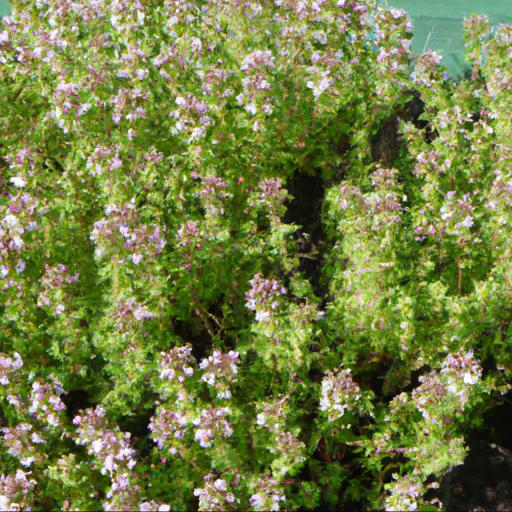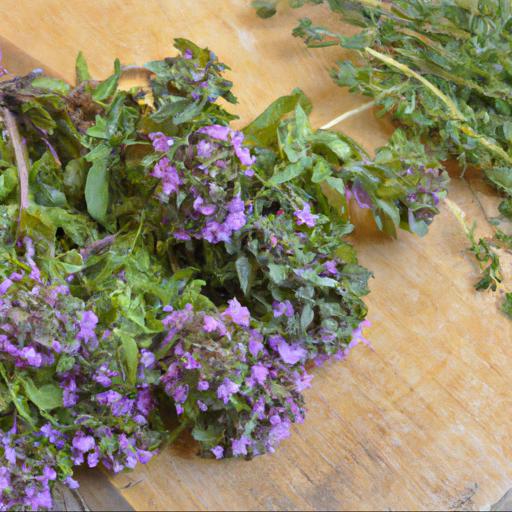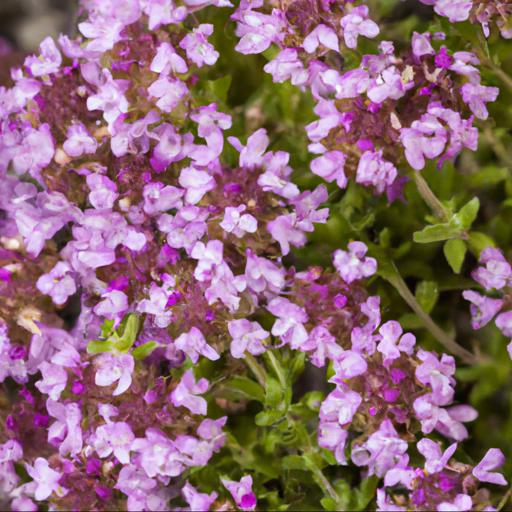Thymus vulgaris, commonly known as Thyme, is a fragrant herb used in cooking and medicinal purposes. It is native to the Mediterranean region and has been used since ancient times to add flavor to dishes, as well as for its medicinal properties. Thyme has been used to treat respiratory problems, digestive issues, and even skin conditions.
It has been found to have anti-inflammatory, antiseptic, and antioxidant properties. Recent studies have also shown that it may be beneficial for improving cognitive function, reducing stress, and fighting off infections.
Thyme is an incredibly versatile herb and its health benefits are far-reaching.
Growing thymus vulgaris: tips and techniques

As a UK garden expert, I’d argue that growing Thymus vulgaris, commonly known as Thyme, is an essential part of any garden. It’s not only an attractive and hardy herb, but also provides a great source of flavour to many dishes.
Here’s some tips and techniques on how to successfully grow your own Thyme. The first tip is to choose the right location. Thyme prefers full sun, so be sure to plant it in an area where it can get at least six hours of direct sun daily.
It also likes well-drained acidic soil, preferably neutral and slightly alkaline, so you’ll want to choose a potting mix that’s suitable for these conditions. Additionally, Thyme can be grown indoors, so think about positioning next to a window where it can get as much sunlight as possible.
Next, it’s important to understand the growing cycle of Thyme. Thyme is a perennial, which means it grows back each year, so planting it in a spot with plenty of sun and good drainage will help to ensure it flourishes. It requires moderate to low water, so it’s best to check the soil and only water when absolutely necessary.
Having said that, it’s important to be aware that it can take a few weeks or months for the small bushes to become established and start to grow. Finally, it’s useful to know the optimal time to start harvesting your Thyme. As Thyme grows, the leaves can be harvested any time throughout the growing period, but the ideal time is usually in the summer when the plant is in full bloom.
To do this, simply pinch the leaves off individual stems, as cutting entire stems can cause stunted growth. By following these tips and techniques, you can expect successful growth of your Thyme, and enjoy the warmth and flavour it adds to your kitchen dishes.
Cooking with thymus vulgaris: recipes and ideas

As a UK expert in gardening, I’m here to tell you about the many wonderful uses for thymus vulgaris, otherwise known as thyme. This is one of the most popular herbs in Europe and is typically used to flavor a variety of dishes, from soups and stews to potatoes and meat.
Thyme is a perennial herb, meaning it blooms and can live for more than two years. It has a distinct scent and flavor, often described as earthy, camphorous, and slightly peppery. It’s also incredibly versatile, lending itself well to warming hearty winter dishes or zesty summer dishes.
With cooking with thymus vulgaris recipes and ideas, you can easily adjust the flavors of your meals and add a unique flair to every dish you make. From stuffed chicken breasts to French-style soups, thyme adds a unique flavor and aromas to any dish. You can also use it in marinades, vinaigrettes, and other dressings, adding a flavorful kick to even the simplest of meals.
You can mix it with other herbs to make a flavorful herb blend that you can sprinkle over roasted vegetables or potatoes. But thyme needn’t just be used in savory cuisine – it’s also wonderful for sweet dishes.
For example, you can make thyme-honey ice cream, or use thyme-infused syrup as a topping for your morning waffles! As a UK garden expert, I urge you to try cooking with thymus vulgaris. From classic dishes to modern-day favorites, this herb is a fantastic addition to any kitchen.
Who knew that this fragrant herb could be so versatile?!
Health benefits of thymus vulgaris

Thymus Vulgaris, otherwise known as common thyme, is a delightful herb that can offer so much to a garden, beyond its distinct and delicious flavor. As a fragrant, low-maintenance perennial, Thymus Vulgaris can provide a garden with not only the opportunity to use its alluring flavor for cooking and medicinal purposes, but also the incredible advantageous health effects that have been attributed to ingesting this herb. The health benefits of Thymus Vulgaris are vast and ample.
Its active ingredients, such as thymol, have expectorant and antioxidant properties that can help in countering congestion and sniffles, while the essential oils contained in the herb can combat bacteria and fight skin disorders. In addition to this, Thymus Vulgaris has the ability to be used in aromatherapy to reduce stress, improve concentration and lift a person’s spirits.
Its natural antibacterial and anti-fungal agents make it an invaluable asset for combatting a variety of illnesses, including asthma, bronchitis, colds and coughs. Not only is Thymus Vulgaris incredibility easy to cultivate and maintain, in the home garden or field, but it is also a resilient herb that can thrive for multiple seasons. It can be grown in container or directly in the soil, and can even be propagated through root cuttings or planting cuttings for a new approach.
Thymus Vulgaris grows best in full sun with well-draining soil and requires minimal pruning in order to thrive. As an added bonus, it will attract butterflies and other beneficial pollinators such as bees to your garden as well.
The health benefits of Thymus Vulgaris are numerous and well worth exploring; there is no denying that its culinary uses, medicinal properties, and easy to ancillary care will make it a favorite ingredient in the home garden. Whether you’re looking to dress up a dish with its lush flavor, or make use of its therapeutic properties, the common thyme is the perfect way to spruce up any garden.
Potential side effects of thymus vulgaris
When it comes to herbal remedies and medicinal plants, the thymus vulgaris is an absolute must have. Thymus vulgaris, commonly known as sweet thyme, is a plant of the mint family. It is native to Morocco, but it can be found in many places throughout the world.
Thymus vulgaris has many medicinal properties, including antimicrobial, antioxidant, anti-inflammatory, antispasmodic and other therapeutic benefits. Due to its various functions, thymus vulgaris can be used to help improve digestive health, aid in the treatment of skin diseases, increase energy levels, and even reduce the symptoms of asthma.
However, as with any remedy, potential side effects of thymus vulgaris should be considered. Some of the potential side effects include allergic reactions in some people, heartburn and stomach irritation.
Although there are potential side effects, thymus vulgaris is generally viewed as safe when used in the proper doses. It is important to consult your doctor before consuming thymus vulgaris. This is especially true if someone has a medical condition or health issue.
It is also important to be aware that thymus vulgaris should not be used with certain medications, as it can interact with them and cause adverse reactions. Overall, thymus vulgaris is a wonderful medicinal plant that provides many health benefits. It is important to understand the potential side effects of thymus vulgaris before consuming it, as well as consulting with a healthcare provider to ensure safety and efficacy.
With the proper precautions in place, sweet thyme can be enjoyed as a safe and effective herbal remedy.
Final Touch
Thymus vulgaris, commonly known as thyme, is a herb that has been used for centuries in traditional medicine and cooking. It is known for its antibacterial and antifungal properties, and is used to treat a variety of ailments such as coughs, colds, indigestion, and even skin conditions.
Additionally, it has been found to have antioxidant and anti-inflammatory properties, making it a great addition to any diet. Thyme is easy to grow and can be used fresh or dried in a variety of dishes.
FAQ
What are the common uses of Thymus vulgaris?
The common uses of Thymus vulgaris include culinary, medicinal, and ornamental purposes. It is used as a culinary herb to flavor soups, stews, and sauces, and as a medicinal herb to treat respiratory and digestive ailments. It is also grown as an ornamental plant in gardens and containers.
What are the health benefits of Thymus vulgaris?
Thymus vulgaris, also known as common thyme, has many health benefits. It is a natural antiseptic and can help to reduce inflammation, improve digestion, and boost the immune system. It has also been used to treat respiratory issues such as coughs, bronchitis, and asthma. Additionally, it has been found to have antioxidant, antibacterial, and antifungal properties.
What are the chemical components of Thymus vulgaris?
The chemical components of Thymus vulgaris include thymol, carvacrol, cymene, linalool, geraniol, and thymohydroquinone.
How is Thymus vulgaris used in traditional medicine?
Thymus vulgaris has been used in traditional medicine for centuries to treat a variety of ailments, including respiratory infections, digestive issues, and skin conditions. It is also believed to have anti-inflammatory, antiseptic, and antioxidant properties.
What are the different varieties of Thymus vulgaris?
The different varieties of Thymus vulgaris include English thyme, lemon thyme, caraway thyme, orange thyme, and wild thyme.
How is Thymus vulgaris cultivated?
Thymus vulgaris is typically cultivated by planting seeds in well-drained, sandy soil in a sunny location. It can also be propagated through cuttings and division.

